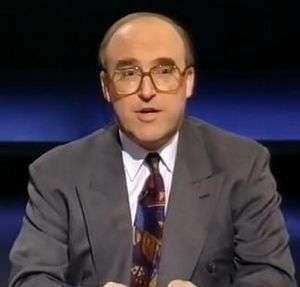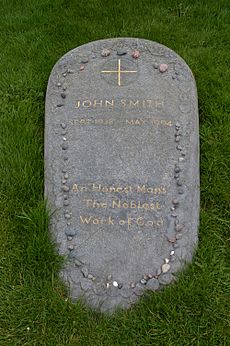John Smith (Labour Party leader) facts for kids
Quick facts for kids
John Smith
|
|
|---|---|

Smith on Question Time shortly before the 1992 election
|
|
| Leader of the Opposition | |
| In office 18 July 1992 – 12 May 1994 |
|
| Monarch | Elizabeth II |
| Prime Minister | John Major |
| Preceded by | Neil Kinnock |
| Succeeded by | Margaret Beckett |
| Leader of the Labour Party | |
| In office 18 July 1992 – 12 May 1994 |
|
| Deputy | Margaret Beckett |
| Preceded by | Neil Kinnock |
| Succeeded by | Tony Blair |
| Secretary of State for Trade | |
| In office 11 November 1978 – 4 May 1979 |
|
| Prime Minister | James Callaghan |
| Preceded by | Edmund Dell |
| Succeeded by | John Nott |
| Minister of State for the Privy Council Office | |
| In office 8 April 1976 – 11 November 1978 |
|
| Prime Minister | James Callaghan |
| Preceded by | The Lord Crowther-Hunt |
| Succeeded by | The Baroness Birk |
| Minister of State for Energy | |
| In office 4 December 1975 – 8 April 1976 |
|
| Prime Minister | Harold Wilson |
| Preceded by | The Lord Balogh |
| Succeeded by | Dickson Mabon |
| Member of Parliament for Monklands East North Lanarkshire (1970–1983) |
|
| In office 18 June 1970 – 12 May 1994 |
|
| Preceded by | Margaret Herbison |
| Succeeded by | Helen Liddell |
| Shadow cabinet posts | |
| 1987–1992 | Shadow Chancellor of the Exchequer |
| 1984–1987 | Shadow Secretary of State for Trade and Industry |
| 1983–1984 | Shadow Secretary of State for Employment |
| 1982–1983 | Shadow Secretary of State for Energy |
| 1979–1982 | Shadow Secretary of State for Trade |
| Personal details | |
| Born | 13 September 1938 Dalmally, Argyll, Scotland |
| Died | 12 May 1994 (aged 55) London, England |
| Resting place | Reilig Odhráin, Iona, Scotland |
| Political party | Labour |
| Spouse |
Elizabeth Bennett
(m. 1967) |
| Children | 3, including Sarah |
| Education | Dunoon Grammar School |
| Alma mater | University of Glasgow |
| Signature |  |
John Smith (1938–1994) was an important British Labour Party politician. He led the Labour Party and was the Leader of the Opposition from July 1992 until he sadly passed away in May 1994. He was also a Member of Parliament (MP) for Monklands East.
Smith first became an MP in 1970. He held several important jobs in the government, like Minister of State for Energy and Secretary of State for Trade. When the Labour Party was not in power, he was a key member of the Shadow Cabinet. This meant he was like a spokesperson for the Labour Party on different topics, such as trade, energy, and finance.
After the 1992 general election, Neil Kinnock stepped down as Labour leader. John Smith was then chosen to lead the party. He worked to make the Labour Party more modern. For example, he changed how votes were counted at party conferences. Instead of trade unions having a big "block vote," every single party member got one vote. This was a big change!
Sadly, John Smith passed away suddenly in 1994. After his death, Tony Blair became the new leader. Blair later led the Labour Party to a big win in the 1997 general election.
Early Life and Education
John Smith was born in Dalmally, Argyll, Scotland, on September 13, 1938. He was the oldest of three children. His father was a school teacher. When John was two, his family moved to Ardrishaig, where he later attended primary school.
From 1952, Smith went to Dunoon Grammar School. He lived away from home during term time. After school, he went to the University of Glasgow. He first studied History and then Law. He joined the Labour Party in 1955.
Smith was very good at debating at university. In 1962, he won a big debating competition called The Observer Mace. After he passed away, this competition was renamed the John Smith Memorial Mace in his honour. In 1963, he became a solicitor, which is a type of lawyer.
Becoming a Member of Parliament
Smith first tried to become an MP in 1961, when he was only 23 years old. He tried again in 1964. Although he didn't win those first elections, he kept trying.
In the 1970 general election, he was elected as the MP for North Lanarkshire. An MP is a person elected to represent a group of people in the House of Commons. This is where laws are made in the UK.
One of his first speeches in Parliament was against a government law in 1970. He also voted to join the European Communities, which was a big decision at the time.
Working in Government
In 1974, Harold Wilson, who was Prime Minister, offered Smith a job as a law officer. But Smith wanted to be more involved in general politics, so he said no.
Later, in October 1974, he became an Under-Secretary at the Department of Energy. This was his first government role. In 1975, he became a Minister of State.
When James Callaghan became Prime Minister in 1976, Smith got another important job. He became a Minister of State at the Privy Council Office. In this role, he helped guide new laws about devolution through Parliament. Devolution meant giving more power to Scotland and Wales to make their own decisions.
In November 1978, Smith joined the Cabinet. This is a group of the most senior ministers in the government. He became Secretary of State for Trade. He was the youngest person in the Cabinet at that time. He held this job until the 1979 general election.
Leading in Opposition
After the Labour Party lost the 1979 election, they were no longer in government. John Smith was elected to the Shadow Cabinet. The Shadow Cabinet is made up of senior politicians from the main opposition party. They "shadow" the government ministers, criticizing their policies and offering alternatives.
Smith held several important "shadow" jobs:
- He was the Shadow Secretary of State for Trade (1979–1982).
- Then, he was the Shadow Energy Secretary (1982–1983).
- He also served as Shadow Employment Secretary (1983–1984).
- From 1984 to 1987, he was the Shadow Secretary of State for Trade and Industry.
In 1983, he became a QC, which is a special title for experienced lawyers.
Shadow Chancellor
In July 1987, Neil Kinnock, the Labour leader, made John Smith the Shadow Chancellor of the Exchequer. This meant he was the main Labour spokesperson on money and the economy.
Smith was known for being witty and sharp in Parliament. He was even named "Parliamentarian of the Year" twice. He often challenged the government's economic policies. For example, in 1989, he famously joked about the government's economic problems by singing the theme tune to the TV show Neighbours.
First Heart Attack
In October 1988, John Smith had a heart attack. He had to take three months off from Parliament to recover. He changed his lifestyle after this. He went on a diet, stopped smoking, and started climbing mountains in Scotland called Munros. He lost a lot of weight and returned to Parliament in January 1989, feeling much better.
Leader of the Opposition
After the Labour Party lost the general election in April 1992, Neil Kinnock resigned. John Smith was then elected as the new Labour leader. This also made him the Leader of the Opposition.
In Parliament, Smith was very good at debating. He often criticized the government, especially after a big economic problem in September 1992. He famously called the Prime Minister, John Major, "the devalued Prime Minister of a devalued Government."
Smith also worked to modernize the Labour Party. At the 1993 party conference, he changed the voting system. Before, trade unions had a "block vote," meaning they cast votes for all their members. Smith changed this to "One member, one vote", giving every individual party member an equal say.
He also promised that a future Labour government would create a Scottish Parliament. This goal was achieved after his death by his friends and successors. During his time as leader, the Labour Party became much more popular in opinion polls. Just before his death, the Conservative government suffered a big defeat in local elections.
Death

On the evening of May 11, 1994, John Smith gave a speech at a dinner in London. The next morning, May 12, 1994, he suffered a fatal heart attack at his flat. He was taken to St Bartholomew's Hospital but sadly passed away.
Many people, including Prime Minister John Major, paid tribute to him in Parliament. The news of his death was a shock across the country.
On May 20, 1994, a public funeral service was held in Edinburgh. He was then buried in a private family service on the island of Iona, Scotland. His grave has a quote from a poem by Alexander Pope: "An honest man's the noblest work of God." Later, a memorial service was held for him at Westminster Abbey.
Aftermath in the Labour Party
After John Smith's death, the Labour Party renamed its headquarters John Smith House in his memory.
Tony Blair became the new leader of the Labour Party. He continued to build on the changes Smith had started. Blair led the party to a huge victory in the 1997 general election, becoming Prime Minister. Many people believe that John Smith had laid the groundwork for this success.
Personal Life
John Smith was married to Elizabeth Bennett from 1967 until his death. They had three daughters. One of his daughters, Sarah Smith, is a well-known news reporter. His other daughters are Jane, a costume designer, and Catherine, a lawyer.
Images for kids
See also
 In Spanish: John Smith (político británico) para niños
In Spanish: John Smith (político británico) para niños



